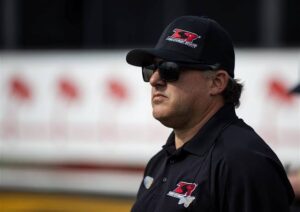Before there was Coach Prime, there was Deion Sanders, the electrifying football star.
The brand would come later, a mélange of highlight-reel plays and compelling sound bites and commercials, and even a rap album that helped preserve Sanders’ place as a sports figure who transcended generations.
The persona was largely forged on the NFL field, where the six-time All-Pro and two-time Super Bowl winner was feared as a cornerback, a return man and occasionally as a wide receiver, but he also ran track in college and moonlighted with a nine-year career in Major League Baseball after being drafted by the Yankees in 1988.
Neon Deion did it all with an incomparable style.
But a constant theme in Sanders’ NFL story, noted by nearly everyone ESPN contacted about their experience with him as a pro between 1989 and 2005, was not Sanders’ flamboyance or even his preternatural athletic abilities. It was the work.
“On the field it was about how good could he be,” said Brad Johnson, who was Sanders’ teammate both at Florida State and in the NFL. “The game wasn’t going to be on Tuesday, Wednesday, Thursday. That was work.”
With the nationwide excitement Sanders has generated in college football as Colorado’s head coach, ESPN reached out to teammates and coaches across all eras of Sanders’ NFL career to provide a portrait of what made him exceptional between the lines on Sundays.
The first widespread public exposure to Sanders came when Bobby Bowden recruited the North Fort Myers, Florida, native to Florida State in the Seminoles’ pre-ACC era. A three-time All-American and also a baseball and track star, it was in Tallahassee from 1985 to 1988 when the legend began to emerge.
Brad Johnson, Florida State QB: A lot of people would not throw to his side, same thing in the NFL. There were times he would entice someone to throw his way. I remember against Michigan State, they had the great Andre Rison, so Deion let him go by him on a post. The QB didn’t throw it far enough and Deion picked it off. He had to entice balls to be thrown his way. He was always before his time.
In practice, he was actually pretty quiet. Prime was into getting better and into working. If we went one-on-one versus him, we might complete a hitch or a curl, but you were never going to complete a go ball. He took it away. That’s who he was. He was an endless worker. Now, on game day, he became Prime Time when the bright lights came on. He could turn it on.
People got caught up in that dance. The dance happens after he scores. I remember him working, I remember the sweat. He was always helping. He was always talking, always helping the other corners out. That didn’t always happen, especially at that time.
Though Sanders’ multisport legend was shaped on the football field and baseball diamond, Sanders was also a track star for the Seminoles. A champion in the 100 and 200 meters and 4×100 relay, Sanders showed a flair for the dramatic and an early aptitude toward unforgettable quips.
Johnson: At Florida State, there was a track meet, and it was him, Dexter Carter, Sammie Smith — another running back who played in the league — and Arthur Blake in the 4×100. The track meet was at 5:30 or so. I’d been playing golf the whole day, so I get home and run down to the track meet. When I park, I feel like I’m late in getting there. When I get to the apartment, he’s outside there in a bathrobe in the parking lot — by the pool — in flip-flops talking on a cellphone. That was a big-ass cellphone; it was 1988. I said, “Prime, you got a meet. Will you be ready to go?” He said, “You never seen a cheetah stretch before he runs, do you?”
On the heels of a celebrated four-year career at FSU and a 4.27 40-yard dash performance at the NFL combine, Sanders was selected No. 5 overall by the Atlanta Falcons in the 1989 NFL draft. The Falcons were in the midst of a stretch of eight consecutive losing seasons (including Sanders’ first two in the league). But in 1990, when the team hired Jerry Glanville as head coach, the franchise’s fortunes began to turn. Glanville respected Sanders’ on-field style, even when it came to the danger of giving wide receivers a huge cushion so he could make plays.
Glanville: He goes, “I gotta lay off to get work. If I smother-cover him, I’m not gonna get any work.” That’s what he’d say. I go, “I know you gotta let him open, but don’t let him open that far because he was open about nine yards.”
Glanville also allowed Sanders to manage all the sideline and celebrity guest appearances, as well as pregame speeches, a practice that Sanders has continued as a head coach at Colorado. Guests of the Falcons back then included megawatt stars like MC Hammer and Evander Holyfield.
Glanville: Hell, they didn’t want to know me. But Deion would say, “Is it OK if I get this guy? Is it OK if I have this guy?” I said, “Hey, do whatever you wanna do if it helps us win.”
So what you see him doing today, I did that way back then. Only because he knew those people. It wasn’t me.
In August 2023, Glanville got a call from former Falcons offensive tackle Chris Hinton, who said Sanders had borrowed from Glanville’s repertoire at a news conference.
Glanville: [Hinton] goes, “He said something you said every week.” I said, “What was it?” He said, “If one’s fighting, we’re all fighting.” He goes, “Do you have any idea how many times you told us that, Coach?” … So I take great pride that he was with us and he gave us a lot.
After five seasons with the Falcons, Sanders signed a one-year, $1.3 million contract with the San Francisco 49ers in mid-September 1994, with the season already underway. Sanders had been playing center field for the Cincinnati Reds, but the strike-inspired end of the 1994 baseball season led to his signing with a 49ers team that had Super Bowl aspirations. Sanders would indeed win his first Super Bowl as well as NFL Defensive Player of the Year honors with six interceptions and an astounding 303 return yards with three touchdowns on those interceptions.
Jesse Sapolu, 49ers offensive lineman: Everybody knew before the season started, it was going to be either one team or the other. It was either the Cowboys or the 49ers. And those predictions came true. … It just shows you how above the head and shoulders those two teams were for the rest of the league. And we brought Deion in for one reason, and that’s to take on [Cowboys future Hall of Famer] Michael Irvin one-on-one and some of the other great receivers from some teams that we might see in the playoffs, and we can roll our coverage the other way. And then when Deion came and his influence on our other cornerback who became a Pro Bowler later, Eric Davis, I mean, now we got something.
Although multiple 49ers teammates had to restructure their contracts to accommodate Sanders’ salary, he immediately connected within the locker room. Offensive coordinator Mike Shanahan remembers his son and later 49ers head coach, Kyle, looking up to Sanders.
Shanahan: Kyle was a ball boy for us — he was probably in eighth grade. He comes to me one day and says, “Deion and some of the veterans are going to take all of the ball boys to dinner, is it OK if I go with them?” I say sure; I think it was Harris Barton, Steve Young, (Tom) Rathman, a bunch of players in that veteran group and Deion. So they go to dinner and Kyle wears his 49ers jersey to dinner, Deion’s jersey, No. 21, that Deion had signed for him. Kyle’s at the restaurant and somebody sees Kyle on the way out and offers Kyle $200 for the jersey. Deion doesn’t see it happen, but all of the other ball boys see it happen, some of the other players see it. Kyle says, “No way, not selling.”








